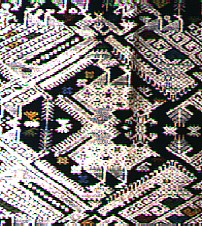| jpweil00@gte.net Steve, I see the two images you point out on the t'ai
textile. I do not see the inherent cultural meaning of the double-image,
though, since I am not familiar with the iconography of the culture. There
could very well be a common interpretation of this symbol and,
additionally, a "secret" meaning, neither of which are evident from
looking, but which , perhaps, would have been discernible by one immersed
in the culture. As far as I know, the pre-Columbian weavings, of cultures
without an otherwise "written" language, are some of the most mysterious,
incomprehensible and enigmatic of any. The secrets of which could have
meant the difference between life and death. I have a hard time
understanding my taxes. A Shaman from H&R Block can help me with them,
though. If I misinterpreted the meaning of a religious weaving I might
have been sacrificed to the Alpaca gods. Patrick
Weiler |
 This is a
detail of a central motif in a T'ai Daeng shaman's head or shoulder shawl
(there seems to be some lack of unanimity among the few experts on which
it is). At first, what you most likely see is a bird with beak open. If
you spend just a little more time with it, you will see a pair of mythical
creatures, elephant-nosed lions, arranged with one facing up and the other
facing down, joined at the head so that the "trunks" of the lions form the
beak of the bird. This isn't secrecy, but is conceptually related to the
notion of concealing parts of a motif (or, at least, I think it is). I
apologize for the quality of the image. It is done from a 35 mm slide; I
don't have a very good slide scanner. Regards, Steve
Price
This is a
detail of a central motif in a T'ai Daeng shaman's head or shoulder shawl
(there seems to be some lack of unanimity among the few experts on which
it is). At first, what you most likely see is a bird with beak open. If
you spend just a little more time with it, you will see a pair of mythical
creatures, elephant-nosed lions, arranged with one facing up and the other
facing down, joined at the head so that the "trunks" of the lions form the
beak of the bird. This isn't secrecy, but is conceptually related to the
notion of concealing parts of a motif (or, at least, I think it is). I
apologize for the quality of the image. It is done from a 35 mm slide; I
don't have a very good slide scanner. Regards, Steve
Price